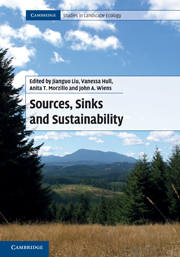Book contents
- Frontmatter
- Contents
- Contributors
- Preface
- Acknowledgments
- Part I Introduction
- Part II Advances in source–sink theory
- Part III Progress in source–sink methodology
- 9 On estimating demographic and dispersal parameters for niche and source–sink models
- 10 Source–sink status of small and large wetland fragments and growth rate of a population network
- 11 Demographic and dispersal data from anthropogenic grasslands: what should we measure?
- 12 Network analysis: a tool for studying the connectivity of source–sink systems
- 13 Sources, sinks, and model accuracy
- 14 Scale-dependence of habitat sources and sinks
- 15 Effects of experimental population removal for the spatial population ecology of the alpine butterfly, Parnassius smintheus
- Part IV Improvement of source–sink management
- Part V Synthesis
- Index
- References
14 - Scale-dependence of habitat sources and sinks
Published online by Cambridge University Press: 05 July 2011
- Frontmatter
- Contents
- Contributors
- Preface
- Acknowledgments
- Part I Introduction
- Part II Advances in source–sink theory
- Part III Progress in source–sink methodology
- 9 On estimating demographic and dispersal parameters for niche and source–sink models
- 10 Source–sink status of small and large wetland fragments and growth rate of a population network
- 11 Demographic and dispersal data from anthropogenic grasslands: what should we measure?
- 12 Network analysis: a tool for studying the connectivity of source–sink systems
- 13 Sources, sinks, and model accuracy
- 14 Scale-dependence of habitat sources and sinks
- 15 Effects of experimental population removal for the spatial population ecology of the alpine butterfly, Parnassius smintheus
- Part IV Improvement of source–sink management
- Part V Synthesis
- Index
- References
Summary
Studies of population dynamics are necessarily contingent on scale, both spatial and temporal extent and grain of study. Observed population dynamics may vary across scales, and different processes may drive these patterns at different scales. Habitat sources and sinks are driven by variation in demographic vital rates such as survival, growth, and reproduction, which often vary widely across spatial and temporal scales. The knowledge that patterns may vary across scales, and different driving variables may be relevant at different scales, is intuitive to ecologists. Merging this awareness of scale with quantitative studies of population dynamics has proven difficult, however. The overall aims of this chapter are to show how scale has influenced studies of source–sink dynamics, and to highlight an emerging statistical approach for better quantifying population dynamics at different scales. After a brief review of how issues of scale are central to understanding source–sink dynamics, we show how hierarchical models can help quantify demographic variation across different scales and make predictions for sparsely populated sites. We use a brief case study of the demography of a forest herb, Hexastylis arifolia (“little brown jug”), to highlight how demographic rates and predicted population growth rates may be quantified at different scales. We conclude with a discussion of important extensions to this work, including the incorporation of dispersal, and the possible implications of scale for assessments of source–sink dynamics.
- Type
- Chapter
- Information
- Sources, Sinks and Sustainability , pp. 291 - 316Publisher: Cambridge University PressPrint publication year: 2011
References
- 5
- Cited by

